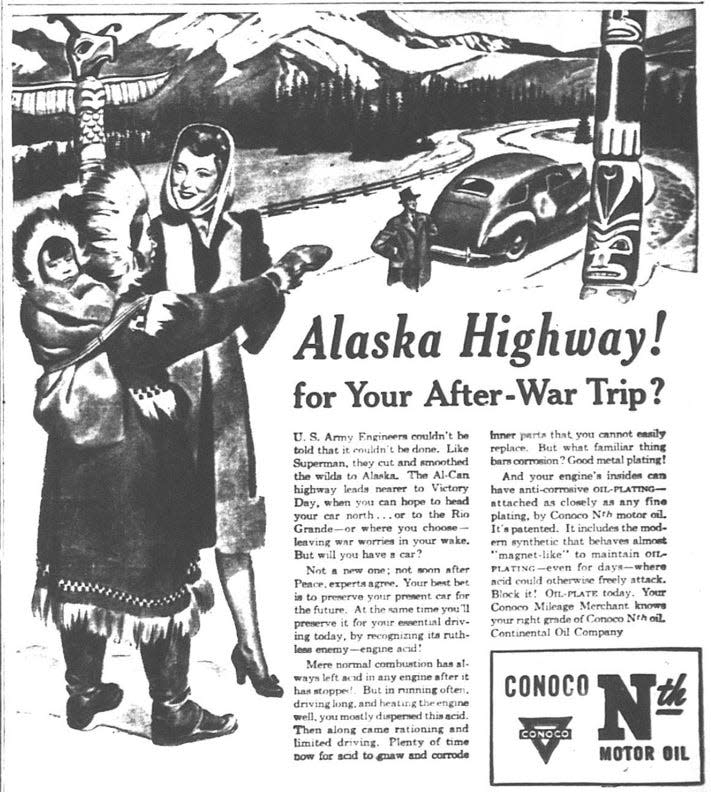Caprock Chronicles: Alaska highway promised much commerce for Lubbock, Part 2
Editor’s Note: The Caprock Chronicles are edited by Jack Becker, Librarian Emeritus, TTU Libraries. This week’s Caprock Chronicles is written by John McCullough, author and aviation historian of Lubbock, who holds a master’s degree in history from Texas Tech. This article is the first in a two-part series about the Alaska highway that was constructed in 1942-43 in response to threats of possible Japanese military incursions there. As final refinements to the Alaska highway neared completion in the spring of 1943, Lubbock leaders envisioned a branch of it being directed south to the Hub City on its way to the ports of southern Texas, the Rio Grande Valley, Mexico, and South America.
As we saw in part one of this series, the United States and Canada agreed to build a military highway from Fairbanks, Alaska to Dawson Creek, British Columbia in March 1942 in response to potential Japanese Army incursions into Alaska during World War II. The Alaska highway would allow for military troops and supplies to be trucked to Fairbanks quickly so that they could then be shipped to settlements and military posts in other regions of Alaska.

Soon, leaders began seeing beyond the military capacity of the Alaska highway and into its possible commercial and civilian uses. Officials proposed that the highway should continue south through Canada and then on to the Great Plains states and finally to the ports of lower Texas, the Rio Grande Valley, and eventually Mexico. Lubbock’s leaders saw an opportunity to have one of these routes directed through the Hub City.
The Alaskan highway was one of the most ambitious construction projects in the early period of the war and involved thousands of civilian workers from both the U.S. and Canada. The initial, primitive highway – mostly composed of dirt but with some areas of it made of wood – was completed by October 29, 1942, and stretched an incredible 1,671 miles.
Originally named the ALCAN (Alaskan-Canadian) highway, the more commonly used name, Alaska highway, was adopted as finishing touches to it were nearing completion in 1943.
With the temperatures warming in the spring of 1943, additional finishing work began in order to smooth out the primitive highway and make it more passable for men and materials.
“The spring thaw damaged the Alaska highway less than feared and already buses like those on highways in the states amaze settlers deep in the heart of the northland.”
Brigadier General James A. O’Connor of the Northwest Service command, “is confident the first land route in history to Alaska will become a permanent year-around road,” stated the Avalanche-Journal on May 14, 1943.
The Alaska highway was now a topic of interest to Lubbockites. In the May 26, 1943, edition of the Avalanche-Journal, the newspaper ran an article on a speech and slide show given by Lt. Galen M. Carr of Abernathy. Lt. Carr showed slide film scenes of various points along the Alcan highway to the Lubbock Optimist club at their luncheon held in the Lubbock Hotel.
Lt. Carr was home on furlough and had to report back for duty in Canada on June 5. For the last seven months, he had been employed on the southern half of the Alcan highway. Soon, officials in Lubbock were ready to make their claim to the Alaska highway.
Highlighting all this excitement was an advertisement in the Avalanche-Journal on June 10, 1943. Its headline read: “Alaska Highway! for Your After-War Trip? U.S. Army Engineers couldn’t be told that it couldn’t be done. Like Superman, they cut and smoothed the wilds of Alaska. The Alcan highway leads nearer to Victory Day, when you hope to head your car north…or to the Rio Grande.”
On Sept. 12, 1943, the Avalanche-Journal reported that Lubbock and Plainview delegations planned to leave soon for Denver, Colorado, for the next meeting of the U.S. Highway 87 association at the Brown Palace Hotel. Charles R. Bacon and A. B. Davis, both of the chamber of commerce, would speak for Lubbock.
“Representatives are expected at the meeting from most of the towns and cities between Great Falls, Montana, and Laredo, Texas, on the highway 87 connecting link between the Alcan highway into Canada and Alaska and the Pan-American highway into Mexico.”
U.S. Representative Angell (R-Ore) told the House on Sept. 15 that construction of the Alaska highway typified the “outstanding road construction by our military forces.”
Angell was a member of the House Congressional committee which went to Alaska and traveled over 1,000 miles of the road by bus, reported the Avalanche-Journal.
“The farthest north through bus service in the world was put into operation this week, when busses chartered by the American Army began rolling into Fairbanks on the Alaska highway,” continued the Avalanche-Journal on Nov. 13, 1943.
Hollywood produced a motion picture about this northern-most military road entitled “Alaska Highway”, starring Richard Arlen and Jean Parker. An advertisement for the motion picture appeared in the Dec. 26, 1943 edition of the Avalanche-Journal, with the tagline “Headline Road Builders!”
In that same edition, the Avalanche-Journal reported that Mrs. C. M. Chandler was to present a short report of the building of the “The Alcan Highway” at the home of Mrs. Charles Smith 2209 Tenth Street two days hence. At that same meeting, Miss Vera Murfee will speak on “Canada: Today and Tomorrow.”
The articles about the Alaska highway and its connection to the Pan-American highway faded over the next few years, perhaps as the focus of officials and citizens turned more to winning the war and enjoying the peace.
This article originally appeared on Lubbock Avalanche-Journal: Caprock Chronicles: Alaska highway promised much commerce for Lubbock

